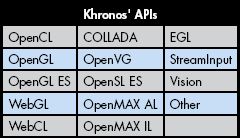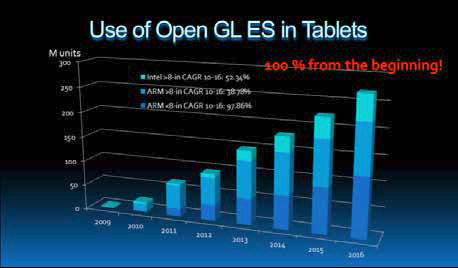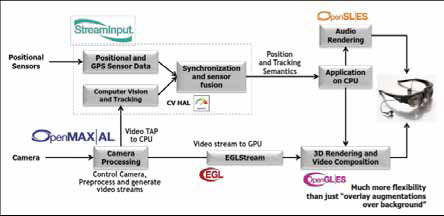The mobile industry has come to rely on Khronos’ APIs as much as the graphics industry. The future is rosy if all industry players pay attention to the bigger picture.
By Jon Peddie
 The Khronos Organization took their name from the god of time. It is appropriate; in this industry timing rules the success and failure of almost everything we do. Some companies are in a death race against time. Time to market is critical in a competitive market, and there is no more competitive market than the mobile phone market.
The Khronos Organization took their name from the god of time. It is appropriate; in this industry timing rules the success and failure of almost everything we do. Some companies are in a death race against time. Time to market is critical in a competitive market, and there is no more competitive market than the mobile phone market.
When developing a product in a competitive market, the temptation is to take a shortcut to save some time, and one of the ways manufacturers save time is to not use standards; they circumvent rules to get to market faster. But when it comes to doing the next generation or keeping up with the industry, they run into problems. Because it is in the next generation when all the bugs and shortcomings show up. Products have to be backward compatible and it gets worse and worse and worse as you go along. Sooner or later, proprietary systems lock out competition and impede time to market.

If each and every processor has its own unique environment, that would be an incredibly hard situation for the software developer. Either you employ multiple development teams, one for each platform or OS, or else you do one platform or OS after the other, which puts the company always behind the curve, late to market. Either way, you lose. Time is not on your side.
Khronos recognized the need for a graphics standard for the mobile industry and developed OpenGL ES, a streamlined version of OpenGL. There was a sense of urgency to get OpenGL ES done because the mobile industry was already starting to explode.

OpenGL ES was important. The Khronos members could see the smart phone market was exploding. Screen sizes were getting bigger, processors were getting more powerful and smaller; all these factors could be easily projected using Moore’s Law. Khronos knew they had to get the API out and in a hurry, and on time. It was obvious that if there wasn’t a good stable platform, there would be chaos that would prevent the market from growing. The early members of Khronos were all major stake holders in the mobile industry.
OpenGL ES proved to be very successful, and so did Khronos. The proof that Khronos had—and has—the right idea and organizational structure is represented in the number of APIs the organization now offers, fifteen. These APIs were developed at the request of the industry, not initiated by Khronos. And further proof, if any is needed, is that Google has released the Android Native Developer Kit (NDK) and unlocked native library support and direct access to graphics interface OpenGL ES 2.0. And it’s not just Google—every other mobile OS (with the current exception of Microsoft) has adopted OpenGL ES. However, in the PC environment OpenGL coexists with DirectX in Windows, so it is at last possible that OpenGL ES will be integrated into Windows in the future.
The market for smartphones has truly exploded, as shown in the chart titled “The Deployment of Open GL ES in Smartphones.” When the smartphone market started to take off in 2005 adoption of OpenGL ES was low. This was partially due to older processors being in the market. By 2014 100% of every mobile phone shipped (with the exception of Window8) will be equipped with OpenGL ES, and that will likely happen before the end of 2013.

Significant market growth is being propelled by Khronos APIs today due to the cross platform and multi-OS coverage of the APIs. The app developers can truly write once/deploy anywhere. Right now, a major challenge for mobile manufacturers is one they are just coming to recognize. Ironically, it comes with the success of Android as manufacturers come up with their own variations of Android in order to have differentiation. Adoption of open standards by Google early in the evolution of the platform can go a long way to alleviate the problem – “adopt early and often.”
In the case of tablets, the market was restarted by Apple in 2009 and there was 100% utilization of OpenGL ES from the start, as shown in the diagram, “Use of OpenGL ES in Tablets.” In the early days of OpenGL ES the effort was to get processor suppliers to write drivers to OpenGL ES. Today that has reversed and the OpenGL ES specification is typically where the SoC developers start their design. There is of course one exception—current WinRT (the main focus for mobile and WOA) has currently excluded every API other than Microsoft APIs—so it looks like ARM-based Win 8 phones/tablets/PCs will not have OpenGL ES—or OpenGL, or CUDA, or anything else—hard to understand in today’s open world. This could be a damper on platform innovation.

And since Microsoft doesn’t have the mobile market share today, not having easier access to all the OpenGL ES apps from Android and iOS isn’t going to help them.
Khronos APIs are popular simply because they work, and work well. They are designed by dozens of the industry’s best engineers, are lightweight (not memory hogs), behave well and play nice with other APIs and apps—Khronos APIs are good citizens. And best of all, they are free.
The next act
Khronos is addressing emerging opportunities—like vision and sensors. Khronos now has the API range to support an entire augmented reality (AR) system. Its Stream-Input initiative is looking at standards for the data coming in sensors including positional, GPS, and computer vision sensors (the most obvious example being Kinect). It will also pull in work from the multimedia API working group OpenMAX/AL with work they’ve already done and will continue to do for accessing video and they’ll link up with EGL for video streaming to the GPU.
The OpenCL/ES working group has relevant work going on in audio rendering; they will team with OpenGL ES for 3D rendering and video composition.

Khronos is also taking work already done in OpenCV as a base. Given all the various technology at play, Khronos is the obvious group to tackle augmented reality.
Khronos now has 113 members worldwide, but with a shocking lack of Chinese companies. The Chinese companies are using the APIs but not driving the industry. It’s as if they’re all in a car and the Chinese companies are just along for the ride.
Use of the APIs is growing. We need more engineers who know how to write drivers to meet these APIs. Khronos is addressing this need by introducing KITE—the Khronos Institute for Training and Education, or technical excellence. The organization is signing up educators to better teach how to take advantage of the APIs.





